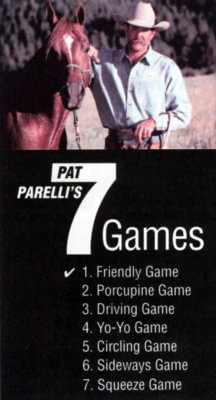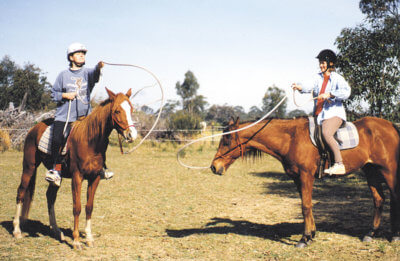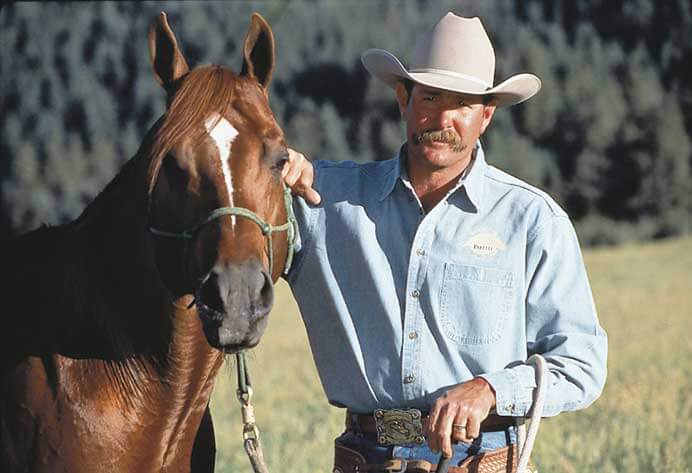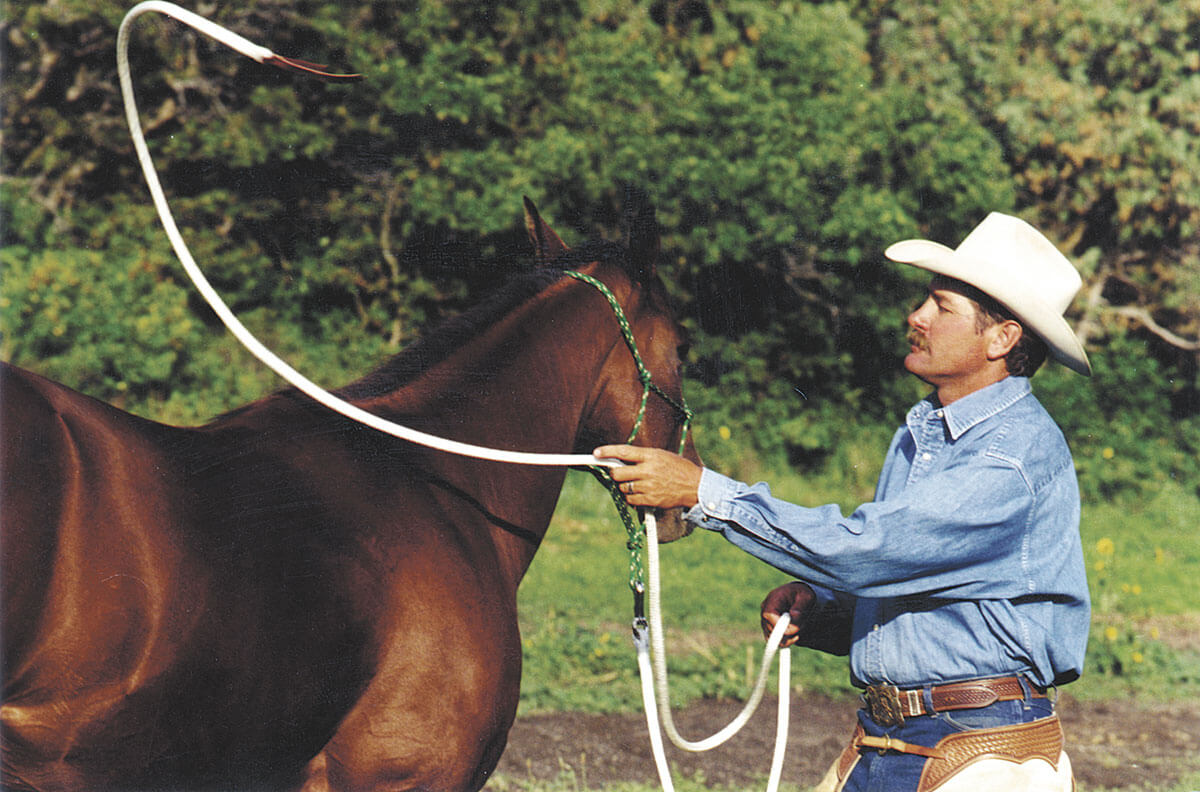Conclusion of Game Number 1, The Friendly Game by Pat Parelli
This is the continuation of the first in a series examining the Parelli Natural Horse•Man•Ship (PNH) Seven Games and their role in establishing leadership as well as building a  language between you and a horse … any horse. The first part of the article ran last month.
language between you and a horse … any horse. The first part of the article ran last month.
Game #1, the Friendly Game, is without a doubt the most important of the Seven Games. Play it with your horse first, before anything else, and then continue to play it before, during and after each of the other Seven Games. You can play the Friendly Game with your lead rope, with a PNH Savvy String, with a PNH Carrot Stick, with a plastic bag on the end of a stick, with a saddle pad, or with your bare hands – use your imagination.
Play the Friendly Game from the tip of your horse’s ears, inside his mouth, down all his legs to the end of his tail. There is no part of your horse’s body you should not be able to be ‘friendly’ with.
Last month I talked about using the Friendly Game to get on a horse that’s never been ridden by earning his trust, by asking permission every step of the way and by never acting like a predator. This month we’ll deal with first impressions, punishment and earning the horse’s respect.
Making a good first Impression with a horse
– Hold the lead rope far away from the halter snap, at least 3 feet, and relax.
Don’t even look at the horse and don’t ask for anything just yet. Most people grab a horse short, right at the halter or snap of the lead rope and hold tight. They want to immediately lead, tie or longe him, often without any introduction or permission to do so. To do the opposite will impress the horse; he will recognize the difference.
– Learn to give the horse a soft look.
Smile and have a relaxed and friendly body language. Sometimes when people are a bit scared this is hard to do, but it will earn you big points. Direct eye contact can feel very threatening to a horse, you’ll notice that a lot of horses will not look at a human. They’ll look away when you make eye contact. As a horse becomes more confident he’ll actually be able to look at you, ears forward and with bright interest.
– Make your time together fun.
Horses love to rub, scratch and chew on each other. Learn to rub a horse like another horse rather than patting him. Find his itchy spots. Be sensitive to areas that he feels defensive about and use an approach and retreat method to help him gain confidence about you touching ‘that spot.’ Above all don’t be impatient. Work progressively until you are able to touch, stroke and rub him everywhere, even under his tail. You can’t force the horse’s trust. You need to gain permission by being friendly.

– Realize that much of what you already do is the Friendly Game.
This could include feeding, watering, grooming, offering carrots or just visiting with your horse in the corral. Horses will often fall in love with their grooms and learn to resent the rider because all the rider does is demand performance. The Friendly Game is the cornerstone of a healthy relationship with a horse, and is the foundation of all we do in PNH.
– Become more provocative; escalate the Friendly Game.
Once you can touch a horse everywhere, use the Friendly Game to desensitize your horse to a potentially startling situation. These could be things like swinging ropes, raincoats, saddle pads, umbrellas, bikes, rolling balls, Frisbees, balloons, people running, jumping, skipping, stumbling, climbing up fences, and noises such as people clapping, bags of cans, cars and trucks. Use your imagination to come up with new variations of the game. Use your imagination to help your horse understand that new things are not threatening. Once he’s convinced, the fear will disappear. He will start to take notice of how you perceive potentially frightening things. If he respects you and you don’t show any fear, he’ll follow your lead.
Punishing your horse
Punishment and reward do not work on horses. Punishment often carries with it a human attitude of anger or displeasure and the horse perceives this as predatory behavior. Also, punishment usually comes too late and the horse cannot associate it with the unwanted behavior. Even worse, some people punish a horse for misbehaving when, in fact, the horse is really just scared out of his wits and acting on instinct.
What does work with horses, is positive and negative reinforcement. I like to use the analogy of an electric fence. The shock is negative reinforcement. It has no emotions. If a horse touches it he gets an instant message that this is a mistake and he can only blame himself. When the horse takes his nose off the electric fence, he gets instant relief. Using this kind of reinforcement will cause behavior changes. Punishment, on the other hand, will ultimately cause a horse to become resentful or turn the situation into a game.
There are two kinds of positive reinforcement: rhythmic motion (rubbing) and neutral (a release or doing nothing at all). There are two kinds of negative reinforcement: rhythmic pressure and steady pressure.
If a horse tries to bite you and you turn to slap him, he’s usually ducked away and won the game. Instead, when he reaches to bite, flap your elbow just at the same time, preferably while not looking at him. If he hits his nose on your arm, then he realizes he ran into something instead of thinking that you attacked him. This is negative reinforcement, the horse needs only to run into something once or twice before the behavior will change.
Positive reinforcement should also be immediate for the horse. ‘Reward’ often comes too late after the fact, and the horse won’t make the connection to his desirable behavior. You need to recognize the slightest try your horse offers and release at that moment. Stop whatever you were asking him to do and let him rest. Because you quit asking, your horse will know that he did something right.
The Friendly Game can be played simply by offering the horse a release and relaxation. You don’t even have to touch the horse; just taking the pressure off will let him know he was right. Another way to show positive reinforcement is to rub the horse. This will become especially important when playing the Porcupine Game (Game #2) and many of the other six games.
Too much of a good thing?
Kindness without control spells disaster. There are many incidences where people pet and feed their horses, offer lots of kindness but get no respect from the horse.
These horses have learned that people are not dangerous. So they try to dominate, push, resist, nip, chase or drag people around because in horse society, the pecking order is very important. After helping your horse overcome his innate fears, if you don’t show yourself to be the leader, then the horse will think that’s his role. This is where games #2 through #7 of the Seven Games become valuable.
Don’t neglect the Friendly Game even if your horse seems gentle enough. Don’t rush through it either, thinking that all you need to do is get your horse to stand still. The Friendly Game is the savvy secret that horsemen use to gain a horse’s trust and to continually reinforce that trust and love. Once you earn the trust, you can begin to ask your horse to yield to pressure, bringing us to Game #2E the Porcupine Game.
For more information on the Friendly Game, part 1 of Pat Parelli’s Savvy System, visit www.parelli.com or call (800) 642-3335
Pat Parelli’s 7 Games
- Friendly Game
- Porcupine Game
- Driving Game
- Yo-Yo Game
- Circling Game
- Sideways Game
- Squeeze Game
Images provide by Parelli Natural Horsemanship
Reprinted from February 2003 Issue

Pat Parelli is an American horse trainer who practices natural horsemanship and founded the Parelli Natural Horsemanship program.






